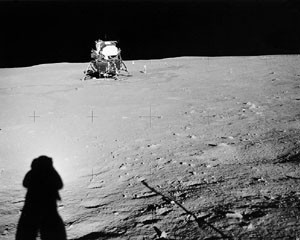|
Size: 306
Comment:
|
Size: 1938
Comment:
|
| Deletions are marked like this. | Additions are marked like this. |
| Line 1: | Line 1: |
| = Lunar Brightness = | #format jsmath = Lunar Brightness at Opposition = When the moon is directly opposite the sun from the earth, it is in eclipse. The angular size of the sun is 0.53° and the angular size of the Earth from the moon is 1.9°. If the moon is within 0.95-0.53 = ±0.42° it is in the dark umbral shadow, and if it is between that and 0.95+0.53 = ±1.48° it is in partial penumbral shadow. If we were in a spaceship directly between the sun and the moon, without the earth in the way, the moon would appear very bright due to heiligenshein, shown below with data for the angular geometry of the Moon, Earth, and sun: ||<|8>{{attachment:p1.jpg}}|| Moon semimajor axis || 384,399 km || || || Moon Eccentricity || 0.0549 || || || Moon Perigee || 362,570 km || 394393 ?? || || || Moon Apogee || 405,410 km || 406728 ?? || || || Earth mean radius || 6371 km || || ||Earth half-angle size|| 0.95° || from moon || || || Sun mean distance || 1.496e8 km || || || Sun mean diameter || 1.392e6 km || || Apollo 11 heiligenshein || Sun angular size || 0.53° || from moon || The |
| Line 5: | Line 21: |
| ---- | |
| Line 6: | Line 23: |
| [[http://hdl.handle.net/2060/19700005062 | NASA SP-201 ]] : Analysis of Apollo 8 photography and visual observations. January 1, 1969. Page 38: Photometry, An Investigation of Lunar Heiligenshein by E. A. Whitaker | |
| Line 16: | Line 27: |
notes: . $ \alpha \equiv $ phase angle between earth and sun as seen from the moon . $ Z $ zenith distance (angle???) |
Lunar Brightness at Opposition
When the moon is directly opposite the sun from the earth, it is in eclipse. The angular size of the sun is 0.53° and the angular size of the Earth from the moon is 1.9°. If the moon is within 0.95-0.53 = ±0.42° it is in the dark umbral shadow, and if it is between that and 0.95+0.53 = ±1.48° it is in partial penumbral shadow. If we were in a spaceship directly between the sun and the moon, without the earth in the way, the moon would appear very bright due to heiligenshein, shown below with data for the angular geometry of the Moon, Earth, and sun:
|
Moon semimajor axis |
384,399 km |
|
|
Moon Eccentricity |
0.0549 |
|
|
Moon Perigee |
362,570 km |
394393 ?? |
|
Moon Apogee |
405,410 km |
406728 ?? |
|
Earth mean radius |
6371 km |
|
|
Earth half-angle size |
0.95° |
from moon |
|
Sun mean distance |
1.496e8 km |
|
|
Sun mean diameter |
1.392e6 km |
|
Apollo 11 heiligenshein |
Sun angular size |
0.53° |
from moon |
The
NASA SP-201 : Analysis of Apollo 8 photography and visual observations. January 1, 1969. Page 38: Photometry, An Investigation of Lunar Heiligenshein by E. A. Whitaker
. Krisciunas & Schaefer, "A Model of the Brightness of Moonlight", Publications of the Astronautical Society of the Pacific, 103: 1033-1039, September 1991.
notes:
\alpha \equiv phase angle between earth and sun as seen from the moon
Z zenith distance (angle???)

